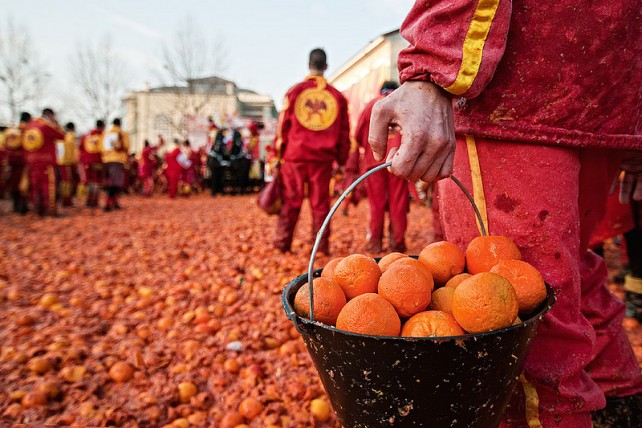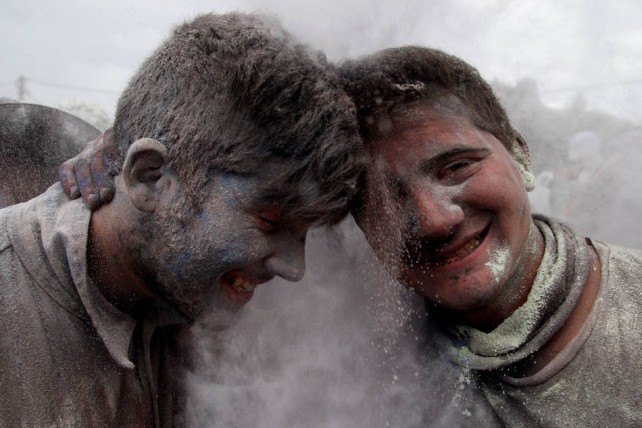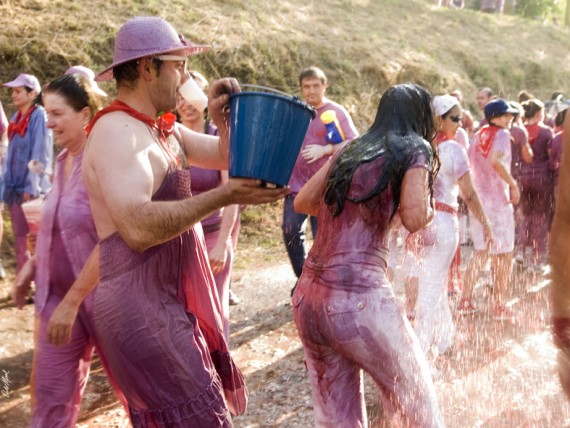While La Tomatina paints Spain red, here are 6 more festivals that also offer a colour splash!
For most of us, throwing tomatoes, by and large, means that it was a bad show or a movie. And hurling these red rotund (and categorically ‘rotten’ in this case) fruits at our targets is another way of saying that ‘Hey, you suck’! But ask any Spaniard, tomato-throwing is as sacred to them as their daily bout of siestas or that essential shot of sangria or playing football.
Remember Zindagi Na Milegi Dobara?

The last Wednesday of August sees this crazy tomato fight where people gather at Bunol in Spain to throw overripe tomatoes at each other celebrating their messiest festival called La Tomatina. Legend has it that near about seven decades ago when two farmers had a tiff, their fight ended in an open battle of tomatoes in the town’s main plaza. But it became such fun that passersby too were tempted to join them in this fight. Gradually that became an annual ritual which now the entire world celebrates by being there during this time of the year. This time, they are celebrating their 70th anniversary and reportedly they have stocked ‘more tomatoes than ever’ for the epic food fight.
Google Doodle too joins in the jamboree:
https://www.google.co.in/logos/doodles/2015/la-tomatina-70th-anniversary-5748008186544128.2-hp.gif
Here are some such festivals that too have a colour splash!
Holi, India

Like La Tomatina, there are many other festivals the world over that are celebrated with a grand splash! While Spain has only red to play with, India boasts of Holi, the festival of colours. Spring would not look so colourful without this festival that is played all across the country. Traditional Holi colours are organically extracted from plants, like yellow from turmeric, purple from beetroot, brown from tea leaves, black from gooseberries and green from mehendi and so on. The Holi fervour has also spread to countries outside Asia. Now many parts of Europe and North America are seen enjoying this as a celebration of love. The original celebration starts with Holika Dahan or Holika bonfire on Phalguna Purnima which signifies victory of good over evil.
Mud Festival, South Korea

If you are in this beach town called Boryeong in South Korea, and one mischievous brat pushes you into that pool of mud, what do you do? Say, ‘Kamsa-hamnida’ (means ‘Thank you’) with a smile for Boryeong’s mineral-rich mud has healing powers. It is used in cosmetics. So, here mud-slinging (literally) works wonders for your skin. This festival started as a marketing initiative to educate people about the goodness of Boryeong’s mud. Now it has grown into an annual summer festival that attracts millions of tourists.
Battle of the Oranges, Italy

Once upon a time there was a cruel tyrant in Ivrea, a northern Italian city. One day while he was trying to force himself on a village bride called Violetta on the day of her wedding, she beheaded him. The entire town was so happy that it stormed his palace that day and burnt it. Since then every February, the town celebrates its victory doing a re-enactment of the battle. As oranges are abundant in supply here, the fruits are used to represent stones.
Clean Monday Flour War Carnival, Greece

This Greek seaside town called Galaxidi breaks into a flour fight on this particular Monday that marks the beginning of the 40-day Christian Lent fast. This usually falls in early March. People play with dyed flour and smear each other’s face with the powder. The white-masted sailing ships of this maritime town were its pride that once ruled the roost. Remembering their glorious past, the residents have been celebrating this for more than 200 years. This is also seen as a protest-festival against the Ottoman rulers.
Songkran Festival, Thailand

You can call it the Thai version of our Holi. Though there’s no colour, as it’s played with water, that doesn’t make it less exciting. Thai New Year called Songkran is celebrated on April 13 every year. This celebration goes on for three days. Revellers fill their water-guns with water and jet it out to have fun. Some fill buckets with ice-cold water to double the merriment. But originally the water was meant to clean statues of Buddha on this occasion. This water was collected and sprinkled on the family members granting them good luck and prosperity. Now it’s a friendly water fight.
Batalla de Vino, Spain

Not just La Tomatina, Spain also revels in another vibrant fest called Batalla de Vino that means battle of wine. June 29, the day of the patron saint San Pedro sees this frenzy when people dressed in white and carrying red wine in all sorts of containers come out to have a grand splash! The friendly free-for-all celebration begins with tossing wine on each other until the entire place turns purple.
Also read
Have you heard about these ‘secret’ Indian festivals?
Madurai’s magnificent festival: One of India’s finest spectacles

OMG-inducing, share-compelling, like-attracting, clutter-breaking, thought-provoking, myth-busting content from the country’s leading content curators. read on...
